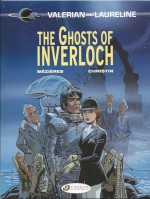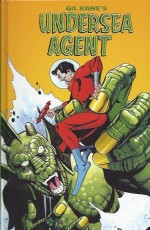
By Méziéres & Christin, with colours by E. Tranlé; translated by Jerome Saincantin (Cinebook)
ISBN: 978-1-84918-263-8
Val̩rian: Spatio-Temporal Agent debuted in weekly Pilote #420 (9th November 1967) and was an instant smash-hit. The feature soon became Val̩rian and Laureline as his feisty distaff sidekick quickly developed into an equal partner Рif not scene-stealing star Рthrough a string of fabulously fantastical, winningly sly and light-hearted time-travelling, space-warping romps.
Packed with cunningly satirical humanist action, challenging philosophy and astute political commentary, the stellar yarns struck a chord with the public and especially other creators who have been swiping, “homaging†and riffing off the series ever since.
Initially Valerian was an affably capable yet unimaginatively by-the-book space cop tasked with protecting the official universal chronology (at least as it affects humankind) by counteracting and correcting paradoxes caused by incautious time-travellers.
When he travelled to 11th century France in debut tale Les Mauvais Rêves (Bad Dreams and still not yet translated into English), he was rescued from doom by a tempestuously formidable young woman named Laureline whom he had no choice but to bring back with him to Galaxity: the 28th century super-citadel and administrative capital of the Terran Empire.
The indomitable female firebrand crash-trained as an operative and accompanied him on subsequent missions – a beguiling succession of breezy, space-warping, social conscience-building epics. This so-sophisticated series always had room to propound a satirical, liberal ideology and agenda (best summed up as “why can’t we all just get along?â€), constantly launching telling fusillades of commentary-by-example to underpin an astounding cascade of visually appealing, visionary space operas.
This eleventh Cinebook translation – beginning another multi-album epic – is especially significant. Each Valérian adventure was first serialised in Pilote before being collected in book editions, but after this adventure – which concluded in The Rage of Hypsis (January 1st – September 1st 1985) the publishing world shifted gears. From the next tale and every one thereafter, the mind-bending sagas were released as all-new graphic novels. The switch in dissemination affected all popular French comics characters and almost spelled the end of periodical comics publication on the continent…
(One clarifying note: in the canon, “Hypsis†is counted as the twelfth tale, due to the collected albums being numbered from The City of Shifting Waters: the second actual story but the first to be compiled in book form. When Bad Dreams was finally released as a European album in 1983, it was given the number #0.)
Les Spectres d’Inverloch originally appeared in then-monthly Pilote (#M110-117, spanning July 1983 to February 1984) and opens here as Laureline enjoys the comforts of a palatial manor in Scotland, somewhere at the tail end of the 20th century. Unflappable dowager Lady Charlotte is the most gracious host and is happy to share all the benefits of life in Clan McCullough, even though her young charge can’t help but wonder why she has to cool her heels with the old biddy in this odd time and place…
Once again the Spatio-Temporal partners-in-peril are separated by eons and light years. Valerian is at the other end of everything: impatiently stuck on water-world Glapum’t, trying to capture a hulking aquatic beast who easily defies his every stratagem. Finally, once brute, force, commando tactics and super-science have all proved ineffectual, the frustrated agent tries bribery. Naturally, the tasty morsels he offers are heavily drugged…
However, as he carries the second phase of his orders, a real problem crops up. Valerian can’t establish contact with Galaxity…
Far ago and elsewhere, London is enduring a paralysing wave of industrial actions. The strikes are particularly galling to volubly affable, infuriatingly unrushed and always tardy Mr. Albert. Galaxity’s 20th century information gatherer/sleeper operative is trying to get to Scotland, but wonders if he’s ever going to get out of the English capital…
On far-flung Rubanis, dictatorial secret police chief Colonel Tlocq is having a duel of wits with the engagingly ruthless data-brokers known as the Shingouz. Naturally, the spymaster is utterly outmanoeuvred by the devious little reptiles who gleefully take off with the secret they required. All-in-all, they are rather enjoying working for Earth…
Way back in West Virginia, Lady Charlotte’s husband Lord Seal is consulting with the CIA. The dapper Briton is a past master of “tradecraft†and remains unperturbed even after reviewing the terrifying situation facing both the Communist Bloc and Free World. Something is making all persons in charge of nuclear weapons – politicians and military alike – go mad. There have been numerous near-misses and even a couple of swiftly hushed-up actual disasters on both sides of the Iron Curtain. Moreover, the Americans have got hold of strange little devices used to cause the insanity. Somebody is deliberately trying to spark atomic Armageddon…
Only the veteran spy’s swift actions prevent the entire assembly going the same way, when a concealed insanity-gadget goes off during their top-secret meeting…
As Seal jets off home, the scene switches to Galaxity. The super-city, impregnable bastion of human dominance, is deserted. Only its supreme master remains, and as the fortress and Terran empire start dissolving into nothingness he makes a desperate jump into time…
On a clear autumn afternoon, Lady Charlotte and Laureline are enjoying the view from Castle Inverloch’s rear windows when the immaculate, lovingly-manicured-for-centuries lawns are wrecked by the crash-landing of a Shingouz shuttle. Naturally, the visitors are granted every gracious vestige of hospitality, even after Lord Seal arrives in flamboyantly bombastic fashion and sees his beloved grass…
Aplomb and grace under pressure alone cannot account for the elderly couple’s acceptance, and when Albert pops in and Valerian shows up – much to the detriment of what remains of the lawns – it becomes clear that the elderly gentry know much more about the workings of the universe than everybody else in this century…
Even the previously-captive Glapumtian – who likes to be called “Ralph†– has a part to play in the baffling, pre-ordained proceedings.
What exactly that means starts to become clear after Lord and Lady Seal introduce their outré guests to the legendary ghost of Inverloch. Valerian usually just calls him “bossâ€â€¦
Soon the Spatio-Temporal Agents are being made painfully aware of a monumental threat to the universe which has already unmade the events leading to the birth of Galaxity and the Terran Empire and which now poses a threat to all that is…
To Be Concluded…
Smart, subtle, complex and frequently hilarious, this sharp trans-time tale beguilingly lays the groundwork for an epic escapade. This is one of the most memorable romps Méziéres & Christin ever concocted, and heralded the start of a whole new way to enjoy the future…
© Dargaud Paris, 1983 Christin, Méziéres & Tran-Lệ. All rights reserved. English translation © 2016 Cinebook Ltd.










